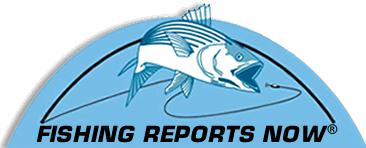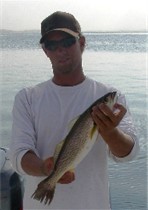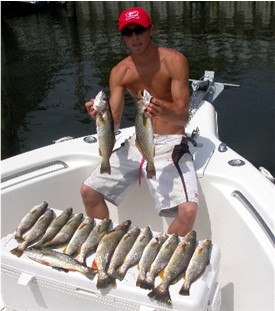| Tie Into Trout on Raritan Bay By Capt. Derek Bieliz, Fishing Price Charters, Highlands Originally Posted 8/10/07 |
||
|
Fishing on Raritan Bay and Sandy Hook Bay opens up to a new type of action in late summer. It’s weakfish time. You can put away the heavy rods, pick up the light tackle and enjoy fast-paced action with these amazing fish. Many areas in Raritan and Sandy Hook bays hold weakfish. The channels are the main places: Raritan Reach Channel, Sandy Hook Channel, Chapel Hill Channel and Terminal Channel near the Earle Naval Pier. An average day begins with riding up and down the channel edges, watching the fish finder for piles of weakfish and signs of bait. If for some reason no signs of life are found in the deep areas of the channels, I’ll start to look at nearby places, like the dredge holes and the flats along the channels. Once a school of the fish is found, I’ll start a drift up current, so that the tide and winds carry the boat and baits over the weaks. This is a light-tackle game, even though the fish can range from 1 ½ pounds to more than 10 pounds, and you never know what kind of fight you could be in for. Still, there’s no need for the 20- to 30-pound tackle used for striped bass or bluefish. We’re talking 8- to 12-pound outfits, either spinning or bait-casting gear. Rods in the 6-½- to 7-foot range are ideal, because they’re usually a little more forgiving on the soft mouths of the weakies. The basic rig consists of a 2/0 baitholder hook, preferably bronze, because I’ve found that the gold hooks attract more hits from bluefish. The hook is tied to a 3-foot leader of 25-pound fluorocarbon. The leader is connected to a 3-way swivel. I usually connect a piece of mono 2 feet long on the other end of the 3-way swivel. I tie a dropper loop on the end of the mono for the sinker, and use a sinker that’s just heavy enough to hold bottom. The line for the sinker can be shortened or lengthened, depending on the speed of the drift. |
|
For a faster drift, shorten the dropper, and for a slower drift, make it longer. Another thing the anglers who fish with me always practice is to constantly bounce the sinker off the bottom. A slow 1- to 2-foot lift is necessary to make sure the sinker is bouncing. The weakfish usually hit as the bait is either being lifted or dropped. In Raritan and Sandy Hook bays, sandworms are the prime bait for weakies. If the worms are small, I normally put two on the hook, threading the first through the mouth, sliding it a quarter of an inch up the hook, and pushing the point of the hook through the side. I then pin the second worm on the hook just through its head. If the worms are big, only one is needed on the hook, and sometimes half is enough to get the job done.
Peanut bunkers are fished on the same rigs as the worms are. Hooking a bunker either in the nostrils or through the lips works well. More hits can usually be picked up with worms, but live peanut bunker will draw attackes from bigger fish if they’re around. Tossing artificials is another way to catch weakies. I always carry a supply of jigs and soft plastic lures in case the weakfish are chasing bait such as rainfish, spearing or peanut bunker. Standard A17’s, both plain and with a yellow tail, are the jigs I’ve found most productive. The trick to remember is that you don’t need to rip the jig through the water like you do when bluefishing. Cast the jig out, and let it sink to the bottom. I take about 10 cranks on the reel, and then let the jig fall back to the bottom, and continue this. Most of the hits will come around 5 feet off the bottom. It takes a few casts until you figure out the correct speed, but once you do, hold on. As far as plastics go, I always carry a variety of leadheads in various weights, ranging from ¼ ounce all the way to 2 ounces. I’ll generally add a Fin-S Fish or Berkley Gulp jerk shad in white, pink or chartreuse. Besides the Fin-S Fish and Gulp, I’ve found that the Zoom Salty Fluke in bubblegum, pearl, and chartreuse will work just as well. Gulp sandworms have also been productive, but I’d recommend adding a real worm with them. Weakies are an aggressive fish, taste great and are a blast to catch on light tackle. On some days it’s not uncommon to go out and catch 80 to 100 or even more than 100 in a single trip, keeping only what you’ll eat, of course. So come on down and enjoy one of the area’s most exciting light-tackle fishing there is to offer. |
||



 Peanut bunker is the second main bait that my charters use for weakfish. The peanuts can be fished live or dead, but the live ones draw more strikes.
Peanut bunker is the second main bait that my charters use for weakfish. The peanuts can be fished live or dead, but the live ones draw more strikes. If the diamond jig has a tail, you have to really watch the speed of the retrieve. You want the tail to swing back and forth, rather than spin. Too fast of a retrieve spins the jig; too slow and the tail will sag.
If the diamond jig has a tail, you have to really watch the speed of the retrieve. You want the tail to swing back and forth, rather than spin. Too fast of a retrieve spins the jig; too slow and the tail will sag.